
MAY CONTAIN NUTS

Search Shorpy
SHORPY ART

Framed or unframed, desk size to sofa size, printed by us in Arizona and Alabama since 2007. Explore now.
Join and Share
Ad-Free Shorpy
Shorpy is funded by you. Patreon contributors get an ad-free experience.
Learn more.

Recent comments
- Say what??
- Grapes?!
- A Beautiful Moment
- Such joy
- Bethune-Cookman University today...
- Yellow sky at morning
- Side Winder
- Air Quality?
- Sojourner Truth riot
- None were so blind(ed)
- The less famous sister
- Good ol' days?
- Rise and Fall
- Goo Goo Ga Joob
- Ticket Retention
- Not the only one
- Vagaries of War
- Killed by Amtrak
- Back to the Future
- Wanted --
- If you can't stand the light
- Centralized Traffic Control, I believe
- What's really happening
- Heckuva remote control!
- Sometimes — Things Go Bump!
- I SEE THE LIGHT
- Union Switch and Signal Company
- Get That Light Out Of My Eyes
- Eggs. Eggs. Eggs. The Egg Man is Here!
- Foreboding caption
Member Photos
The Shorpy
Print Emporium
Print Emporium
Search Shorpy
Search results -- 30 results per page
- New York Life: 1900
- ... do so until 1906.
Lost Craftsmanship I'm amazed daily by the amount of masonry craftsmanship used on the upper floors of early ... Posted by Dave - 07/02/2017 - 2:28pm -
![New York Life: 1900 September 11, 1900. "New York Life building, Chicago." The building, at LaSalle and Monroe streets, was completed in 1894, with major additions in 1898 and 1903. 8x10 inch glass negative, Detroit Publishing Company. View full size.
Lasalle and Monroe: 2017Like many other Loop properties, this has been converted to a boutique hotel. The Kimpton Grey Hotel opened in 2016.
Look Out for the CurveThat continuous line of hatch covers between the inner rail and the slot as the streetcar track goes around the corner means that this was a "pull curve", the cable car had to hold on to the rope all the way around, and would do so until 1906.
Lost CraftsmanshipI'm amazed daily by the amount of masonry craftsmanship used on the upper floors of early buildings like this. Decoration and ornamentation in places or so high they'll never be fully appreciated by those at ground level.
Headless horse?There appears to be a headless horse in front of the building.
I hope this is not really the case.
Cornice-ectomyIt would be a nice, classy gesture if they replaced the original, prominent cornice. I am not, however, holding my breath.
[One way they're dealing with cornices in Detroit. -tterrace]
"Cornice Danger" prompted removalsNumerous buildings lost pieces or whole sections of their uppermost cornices as age and freeze-thaw took their toll on the materials through the 1920s and 30s.
In 1938 the City gave itself the authority to require owners to remove cornices deemed dangerous. This threat was enough that by the 1950s wholesale decapitation of these elements was underway.
However, given the successful restorations of several cornices in recent years (like the Marquette building just around the corner on Dearborn) it is surprising that the just performed hotel conversion did not add this historic element back. Probably it was just deemed too expensive, or, if historic tax credits were involved, there wasn't clear enough documentation of the original to cornice to do it to preservation standards.
(The Gallery, Chicago, DPC)](https://www.shorpy.com/files/images/SHORPY-4a08129a.thumbnail.jpg)
- Gotham Gulch: 1911
- ... of their loved ones who had sailed on the Titanic. Twice daily the line posted updated lists of survivors outside the doors to their ... Posted by Dave - 05/07/2020 - 4:19pm -
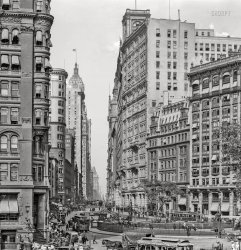
- Old Man River: 1910
- ... before us who seemed to have performed superhuman feats daily in order to provide for all of us and to build up America. They must be ... Posted by Dave - 07/14/2014 - 6:37pm -
![Old Man River: 1910 The sternwheeler City St. Joseph on the Mississippi River circa 1910. "Unloading cotton on the levee. Memphis, Tennessee." 8x10 glass negative. View full size.
Cotton talkDriving around the South in October you can see what, to some, look like giant loaves of bread sitting at the side of the cotton fields. These are called "Cotton Modules" and are compacted cotton picked by machines waiting to be shipped to the cotton gin. Each module holds approximately 14.5 to 15 bales of cotton. A bale of cotton is said to average around 500 pounds.
Tote that barge, lift that baleAt the time this photo was taken, my mom was a newborn to a coal miner in Pennsylvania, while in a Conn. copper foundry, my father's dad was toiling in front of a blast furnace 8 to 10 hrs. a day. These were not easy times for most people who had to do the hard labor necessary to support their families. Meanwhile in Memphis, these men were also enduring backbreaking jobs to make a buck. I've heard countless stories of the generations before us who seemed to have performed superhuman feats daily in order to provide for all of us and to build up America. They must be remembered as heroes. We sometimes don't realize the effort involved in turning raw materials into useful products.
Rollin' On the RiverNow we know the true meaning of the phrase.
BailI assume that's a bail of cotton? Three men pushing each, how much did they weigh? (not the men)
[More like a bale. "Bail" is for jail. - Dave]
(The Gallery, Boats & Bridges, DPC, Memphis)](https://www.shorpy.com/files/images/SHORPY-4a23587a.thumbnail.jpg)
- Double Bill: 1926
- ... room, a library or drab lodging.
Further there is the daily levy of one hour of her time by the requirements of voice and piano ... Posted by Dave - 12/03/2013 - 9:41am -
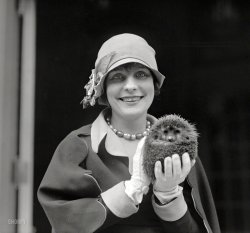
- Mildred Lodge: 1915
- ... owned by William Watson and his wife, Anna. The Daytona Daily News of January 29, 1910, carries an ad for the Mildred Lodge, formerly ... Posted by Dave - 08/12/2021 - 1:57pm -
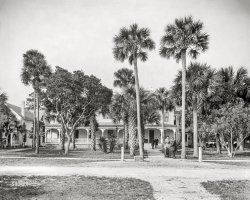
- Priscilla Mills: 1911
- ... that so many boys, barely in their teens would go about daily life without shoes.
I wonder what the top on that road is ... Posted by Dave - 05/28/2012 - 12:42pm -
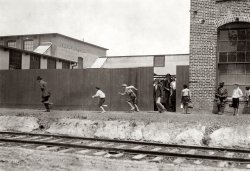
- Daddy: 1915
- ... As the church's fifth dean, he also presided over daily operations and focused on finishing the massive Gothic structure whose ... Posted by Dave - 09/13/2011 - 11:22am -
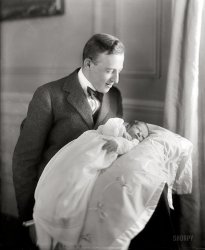
- Sherman Avenue: 1908
- ...
Westward Ho! I enjoy checking out Shorpy on a daily basis, but seldom comment. So nice to see something from the West! ... Posted by Dave - 08/21/2012 - 8:37pm -
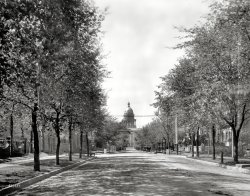
- Courtesy Service: 1940
- ... contact with the aforementioned safeguards in-place. Daily contact requiring repairs aren't uncommon.
I can only imagine how ... Posted by Dave - 11/09/2018 - 10:49am -
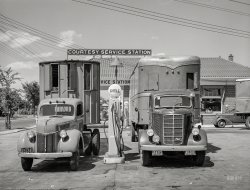
- Old Paint: 1925
- ... the other truck as clues I'd say we're at the Washington Daily News. - Dave]
(The Gallery, Cars, Trucks, Buses, D.C., Natl Photo) ... Posted by Dave - 09/11/2011 - 12:27pm -
![Old Paint: 1925 Washington, D.C., 1925. "Ford Motor Co." A delivery truck for Hugh Reilly Paint and Glass. View full size. National Photo Company Collection glass negative.
High tech inflatable tiresSo not everyone used those horrid solid things. I guess paint isn't as heavy as coal.
How-ToAmusingly illustrated instructions for folding a pressman's hat.
HeadlightsLooks like one is set to check for potholes, the other set to look for squirrels.
The WatcherLove the guy standing back there having a smoke. As if he is saying "why dont you take a picture of me, I got a cool hat."
[It's a pressman's hat made of newsprint. With that and the other truck as clues I'd say we're at the Washington Daily News. - Dave]
(The Gallery, Cars, Trucks, Buses, D.C., Natl Photo)](https://www.shorpy.com/files/images/15115u.thumbnail.jpg)
- North From Locust: 1907
- ... change for print media. Philadelphia lost two of its four daily papers and magazines skyrocketed in price. The handwriting was on the ... Posted by Dave - 08/25/2014 - 10:06am -
![North From Locust: 1907 Philadelphia circa 1907. "Broad Street north from Locust with view of City Hall." 8x10 inch glass negative, Detroit Publishing Company. View full size.
+106Below is the same view from October of 2013.
Advanced Vaudeville?I noticed the sign for Advanced Vaudeville. Is there such a thing as beginning vaudeville? Nice shot of the 2013 view.
[1907 poster for Klaw & Erlanger's "Advanced Vaudeville". -tterrace]
Ah! Thanks (baxado)
NewsstandIn 1974, I purchased the newsstand that you can see in the 2013 photo. Stayed there for ten years and earned a very good living. Then it started to change for print media. Philadelphia lost two of its four daily papers and magazines skyrocketed in price. The handwriting was on the wall and I got out.
(The Gallery, Cars, Trucks, Buses, DPC, Philadelphia)](https://www.shorpy.com/files/images/SHORPY-4a18176a.thumbnail.jpg)
- DRUGS SODA: 1939
- ... prime parking location to lure innocent kids in for their daily DRUG and SODA fixes? ... Probably sold candy cigarettes too!
(The ... Posted by Dave - 01/10/2018 - 10:39pm -
![DRUGS SODA: 1939 October 1939. "Stores on main street (G Avenue). Grundy Center, Iowa." Photo by Arthur Rothstein for the Farm Security Administration. View full size.
That Corner TowerWould love to see the structural details for that wonderful corner tower.
Agree: probably structural steel behind that masonry, but just how. Nifty what engineers and arkies were able to conjure up before computers came along, just using a K&E slide rule.
Roof blown off?That must have been some party...
MaintenanceRegarding the demise of not only the dunce cap on the corner feature, but the false fronts on two sides of the building, I'm guessing that those features needed roofing and tuckpointing, and perhaps also a bit of carpentry work when the wood underneath rooted. Presented with a quote for repairs, and a quote for removal, the owner made a simple choice.
I'm guessing that round tower is also tied in with the same structural steel that allows the building to have those wide store windows.
Vehicle ID pleaseWhat model of car is the one parked right out front, with the Grundy National Bank awning right above it?
Love it.
[1939 Ford Tudor Sedan. -tterrace]
Thanks! And thank you to Dave and tterrace for posting all these great images!
Happy New Year to all of ShorpyLand!
OrielThe name for the corner tower / feature. Specifically, a corner oriel. An oriel window is a bay window that does not extend all the way to the ground.
The Pusher ManA cobbled-together wooden bike rack in the prime parking location to lure innocent kids in for their daily DRUG and SODA fixes? ... Probably sold candy cigarettes too!
(The Gallery, Arthur Rothstein, Small Towns, Stores & Markets)](https://www.shorpy.com/files/images/SHORPY-8b19076a.thumbnail.jpg)
- Truck Stop Cafe: 1940
- ... of the day, so these Kings of the Road were getting their daily portion of salt and then some.
Interesting windows... I'm ... Posted by Dave - 08/24/2012 - 2:10pm -
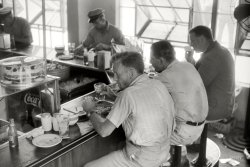
- Bungalow of Doom: 1941
- ... pit iron mine. Houses in this section are being demolished daily as mining operations expand." Medium format acetate negative by John ... Posted by Dave - 02/24/2020 - 9:27pm -
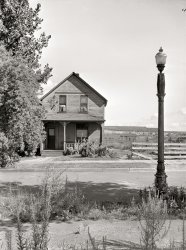
- Tooth and Nail: 1917
- April 1917. "Daily inspection of teeth and fingernails. Older pupils make the inspection ... Posted by Dave - 09/08/2011 - 6:50pm -
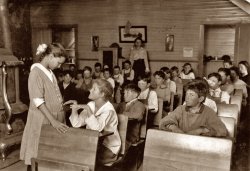
- Dinosaur: 1924
- ... T.J. Horner and J.N. Barrett, assistant curators, are daily excavating fragments of the tail from solid rock, in the basement of the ... Posted by Dave - 09/03/2012 - 9:45am -
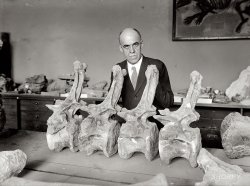
- Miss Maxwell: 1922
- ... spills. Yet women bought and wore leg-warmers proudly on a daily basis, all bunched down around the calves, which did little to keep the ... Posted by Dave - 11/16/2015 - 1:08pm -
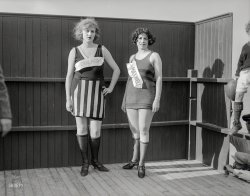
- That Edwards Boy: 1921
- ... of current news events in Washington, D.C., as a daily service to its subscribers. It also prepared sets of pictures on popular ... Posted by Dave - 10/04/2012 - 2:54am -
![That Edwards Boy: 1921 Washington, D.C., circa 1921. "Edwards boy at Octagon House." The enigmatic E-Boy, back for his sixth appearance. National Photo Co. View full size.
Just a thoughtThis Edwards boy thing. I'm just thinkin'. Maybe a newspaper in some town in the hinterlands did this as a series or photospread.
[From the Library of Congress Prints and Photographic Collection catalog: "The National Photo Company Collection documents virtually all aspects of Washington, D.C., life. During the administrations of Presidents Wilson, Harding, Coolidge, and Hoover, the National Photo Company supplied photographs of current news events in Washington, D.C., as a daily service to its subscribers. It also prepared sets of pictures on popular subjects and undertook special photographic assignments for local businesses and government agencies." - tterrace]
A Tale of Two BoysBoth Shorpy Higginbotham and The Edwards Boy celebrate their fifth cyber-birthdays this year (S.H. in February, T.E.B. this December), but regrettably the identity of the latter remains buried in the mists of time. Or in the emulsions of plates. Too bad he didn't have a less common name, like Oglethorpe, that would facilitate Joe Manning-style tracking.
Re: A Tale of Two BoysEB visited a lot of places in Washington so maybe he was the Son of a Congressman or Senator, or at least the Son of someone with enough clout to get him in all these places, or maybe he just won a contest.
I'm still waiting to find out who Kermy was, at least there's a chance he's still alive and could have a meaningful dialog with us.
Octagon? No, Still There!The house is still there, but the numbers have been changed to protect the innocent! It's at 1799 New York Ave, NW.
After the White House was burned by the British during the War of 1812, the Octagon house served as the executive mansion for President James Madison. In Master Edward's day it was open for public tours. Presently, it's a museum of architectural design.
(The Gallery, D.C., Edwards Boy, Natl Photo)](https://www.shorpy.com/files/images/SHORPY_29792u.thumbnail.jpg)
- Stuff It: 1922
- ... the subject. Every one of the boys and girls takes an hour daily for exercise and shower bath. An auditorium is in use each period. From ... Posted by Dave - 08/21/2012 - 11:19am -
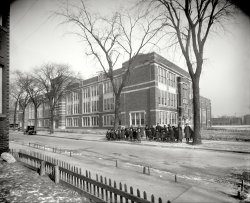
- City of Ottawa: 1907
- ... in that reservoirs mounted over the sinks were filled daily by the stewardesses and after that gravity did the rest. The galley was ... Posted by Dave - 01/22/2018 - 11:21pm -
![City of Ottawa: 1907 Cleveland circa 1907. "Steamer City of Ottawa entering Cuyahoga Creek." 8x10 inch dry plate glass negative, Detroit Publishing Company. View full size.
What is supporting that bridge?Was this photo somehow manipulated or am I just not seeing the bridge/ferry landing properly? The shadows do not look correct, nor does the water beneath it. Is the dark pile which is barely visible made of steel, and all that is bearing the weight?
[It's a swing bridge in the open position. -tterrace]
Thanks Dave...makes perfect sense now! I hadn't considered that it was pointing 90 degrees from its normal orientation :-) (even though I have a defunct center pivot one close by)
The Name GameCity of Ottawa had a pretty long life on the lakes, a nearly went further. Christened the INDIA in 1871, she joined sister ships in service known as CHINA and the JAPAN. From the annals of the Toronto Maritime Society, these were no run of the mill steamers plying the Great Lakes.
"...The passenger cabin of each was a veritable palace compared to other ships then operating. The staterooms opened off a long open passageway in which the dining tables were set at mealtimes. At the forward end of the cabin was the men's smoking room, while at the after end of the passenger area the cabin opened out into a spacious and luxuriously appointed ladies' cabin, complete with grand piano. The woodwork up to the level of the clerestory was varnished, while the deckhead was painted white. Woodcarvings were in evidence everywhere. The entire cabin was fitted with carpeting and an elegant companionway led down to the main deck where the purser's office was located. As usual for the period, bathroom facilities were not provided in the staterooms but each room did boast "running water" in that reservoirs mounted over the sinks were filled daily by the stewardesses and after that gravity did the rest. The galley was located on the main deck and the food (of excellent repute) was brought to the cabin by means of a primitive lift."
Ironically, while she went by City of Ottawa renaming for most of her sailing days, the ship started as INDIA and ended that way as well, while being refitted for saltwater use during WWII. She was sent down the Mississippi River to New Orleans but deemed too old and unfit, was eventually laid up along Lake Ponchartrain, where it's believed she meet her end to scrappers in 1945.
Launched on June 20, 1871 at Buffalofor the Atlantic, Duluth & Pacific Company by Gibson & Craig and the King Iron Works, the India was the first of a trio of state-of-the-art iron passenger and freight vessels running between Buffalo and Duluth, the others the China and Japan. Beginning the next year and for the next decade it ran for the Lake Superior Transit Company, allied with a pool of railroad-related steamship companies and after that with the Anchor Line, part of the Pennsylvania Rail Road. Sold in 1906 to the Montreal & Lake Erie Steamship Company, reflagged Canadian, repowered, and renamed the City of Ottawa, the vessel operated as the firm's name implies. Its passenger accommodations were removed in 1913 when Canada Steamship Lines Ltd. acquired the vessel and placed it in the package freight trade between Hamilton and Montreal. Laid up in 1926, the City of Ottawa was sold back into American registry briefly in 1928 and renamed India, and the next year back into Canadian registry for the Algoma Central Railway Company and renamed Sault Ste. Marie, running between Fort William and Toronto. In 1930 it again entered American registry and reverted again to the name India, cut down to a coal barge. Requisitioned by the Maritime Commission for war service in 1942, the India was brought down the Chicago River, Sanitary and Ship Canal, and the Illinois and Mississippi Rivers for a conversion that never occurred. The India was dismantled on the shore of Lake Pontchartrain in 1945.
The William L. Scott was built at Buffalo in 1890 by the Union Dry Dock Company for that city's Hand & Johnson Tug Line. It was abandoned and dismantled in 1915, probably at Erie, Pennsylvania.
Swing bridge?Never was a real fan of bridges that move. Really like them sitting still and anchored.
Getting A LiftFor fans and non-fans of moving bridges, the current edition at or near that same spot is a rather impressive rail lift bridge, rather than swing version. Everything's up to date in Cleveland.
Tugging at your heartThe tug WILLIAM L. SCOTT, built in 1890, was steam powered and of wood construction, weighing 54 gross tons, with dimensions of 67.9 x 17.4 x 10 feet. It was dismantled in 1915 at Union Dry Dock, Buffalo Shipbuilding.
I suspect the boat may have been named for Pennsylvania congressman William Lawrence Scott (1828-1891).
(The Gallery, Boats & Bridges, DPC)](https://www.shorpy.com/files/images/SHORPY-4a25406a.thumbnail.jpg)
- Band of Brothers: 1924
- ... could begin the actual work of construction.
They sold daily papers and periodicals until something like $45 had been accumulated. ... Posted by Dave - 09/03/2008 - 10:45am -
![Band of Brothers: 1924 1924. "Children of Mrs. Milan Getling" (actually Getting). National Photo Company Collection glass negative. View full size.
Getling BoysFine-looking boys. They needed a comment.
[They and I thank you. Love the cartoons btw. - Dave]
Boy Puppeteers Washington Post Feb 10, 1924
3 Sons of Attache Win Applause
Here with Marionettes
Boys of Milan Getting, of Czechoslovakian Legation,
Built Little Theater
Take notice all ye theater guilds, little theaters and amateur theatrical organizations, Czechoslovakian talent has come to town and marionettes are bidding for headline honors.
The boys, ages 14, 12 and 10, sons of Milan Getting, attache of the Czechoslovakian legation in Washington, have built a marionette theater, and during the past week presented a play at the Ambassador under the public service department of the Crandall theaters.
Months of hard labor after school hours constituted the preliminary of this entertainment, because Milan, Vlado and Ivan Getting first had to earn the money for materials before they could begin the actual work of construction.
They sold daily papers and periodicals until something like $45 had been accumulated. This sum was sent to their home city, Prague, for lithographs to be used as scenes and for a king, queen and a princess marionette. The boys did not feel quite equal to royalty in their first venture in carving the little wooden dramatis personae.
The play itself was ready, "The Enchanted Forest," which had won the first prize for marionette shows in Prague several years ago, had been translated into English by Milan.
So when the material from Bohemia arrived, the boys' workshop at their home, 1727 S street, became the place for the completion of their venture.
...
A Getting Grandchild Thanks You!Thank you for posting this piece of our family history. The eldest son, Milan, is my late grandfather. Our elders commented often about the puppets, but this article provides detail I had not known. I had never seen this photograph and had even tried (without success) to figure out where the family lived in D.C. (And yes, the correct spelling is GETTING)
Again, THANK YOU!
Pamela Getting Stauffer
[You're very welcome. The credit goes to tireless and resourceful researcher Stanton Square. Below, a photo of your granddad. Click to enlarge. - Dave]
Unspeakable GratitudeI am speechless. For the three Getting boys, this was a very important part of their life that I have wanted to learn more about and I just now stumbled upon your web pages. Where did you find these? I cannot thank you enough for sharing this.
[The photo is part of the National Photo Company Collection, donated to the Library of Congress in 1947. There is a slightly different version here (larger version here). There's more about the brothers in the Washington Post archives, which you can view online if you have a ProQuest login. Which you probably have access to if you have a library card. Check your public library's website under "research" or "online resources." - Dave]
(The Gallery, Natl Photo, Portraits)](https://www.shorpy.com/files/images/10494u.thumbnail.jpg)
- Harlem River Speedway: 1905
- ... end of the speedway and exercised his famous horse there daily. C. K. G. Billings is one of the few to continue to use the drive.
... Posted by Dave - 08/20/2012 - 1:38am -
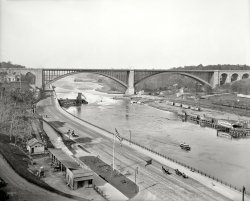
- Owana at Toledo: 1912
- ... size.
Sidewheeler Owana The Owana operated a daily schedule departing Detroit in the morning, and Toledo in afternoon. ... Posted by Dave - 10/29/2012 - 10:42pm -
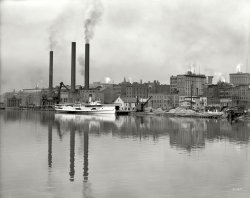
- Urban Onions: 1942
- ... Three Art Deco masterpieces of 1929-30: The Daily News (right), the Chanin Building (left) and the unforgettable Chrysler ... Posted by Dave - 02/21/2015 - 3:07pm -
![Urban Onions: 1942 June 1944. "New York. School victory garden on First Avenue between 35th & 36th streets." Photo by Edward Meyer, Office of War Information. View full size.
Guerilla gardening?I guess that "guerilla gardening" would be a more modern term.
[Victory Gardens had the full support of the government. -tterrace]
["Guerrilla" with two R's would be even more modern. - Dave]
My old neighborhoodI used to live a couple of blocks from there. That location is a small park on one side of the street, and an apartment complex on the other.
Art Deco masterpiecesThree Art Deco masterpieces of 1929-30: The Daily News (right), the Chanin Building (left) and the unforgettable Chrysler in the center, of course. The one to the extreme left is One Grand Central Place, formerly known as the Lincoln Building, also completed in 1930 and designed in the neo-gothic style.
One Grand Central PlaceThe one to the extreme left is One Grand Central Place, formerly known as the Lincoln Building; also completed in 1930 and designed in the neo-gothic style.
(The Gallery, NYC, WW2)](https://www.shorpy.com/files/images/SHORPY-8d35488a.thumbnail.jpg)
- Promote Email Updates - 12/10/07 & 11/30/07
- ... up for our new, free e-mail newsletter and receive a daily update with the latest images posted on Shorpy.
We won't spam you or sell you your name to those who do. But we do promise a daily dose of photo goodness. Sign up today .
If you prefer RSS feeds, ... Posted by Ken - 12/10/2007 - 9:38pm
- Sidelined: 1942
- ... Freeman for the Office of War Information. After the daily business began to dry up along with gas supplies, parking-lot operators ... Posted by Dave - 02/21/2015 - 2:39pm -
![Sidelined: 1942 1942. "Effect of gasoline shortage in Washington, D.C." Medium format nitrate negative by Albert Freeman for the Office of War Information. View full size.
Deja vu all over againSame location as the one we saw earlier, but from a higher POV and on a different day.
Sidelined?I'm curious about your title Dave; looks like a normal downtown work day parking lot. Probably pretty empty after the work crowd and evening theater attendees all go home.
[The title goes with the caption: "Effect of gasoline shortage in Washington, D.C." One of 17 photos taken by Albert Freeman for the Office of War Information. After the daily business began to dry up along with gas supplies, parking-lot operators began moving their business to monthly storage contracts for the duration of the war. - Dave]
It's a StretchThe author of the original caption was clearly having a bad day, logic-wise. This is a short-term parking lot, filled nearly to capacity with cars that presumably came from somewhere and will return there at the end of the day, consuming gasoline in the process. With no pre-rationing baseline for comparison, this photo could as easily reflect the situation on 5 December 1941.
Now a shot of acres of cars in long-term storage or urban streets and commuter highways nearly devoid of traffic would merit such a caption. Still, it's a great shot of some nice old rides, and amply illustrates what a drag it must have been to work there: "Mine's the Airflow behind the Chevy, up against the wall, and I'm really in a hurry!"
[The caption comes from the Library of Congress catalog card for a collection of negatives depicting cars parked in a variety of situations in Washington, D.C. -tterrace]
(The Gallery, Albert Freeman, Cars, Trucks, Buses, D.C.)](https://www.shorpy.com/files/images/SHORPY-8d36718a.thumbnail.jpg)
- Wrapped in Plastic: 1961
- ... instruction, Helena Rubinstein is now offering daily classes in glamour and corrective make-up in her salon at 655 Fifth ... Posted by Dave - 01/11/2014 - 4:54pm -
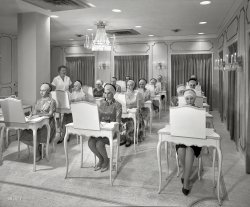
- Dinner to Go: 1921
- ... for the White House table.
The bird was grown by M.H. Daily, prohibition commissioner of Mississippi, whose home is at Crystal ... Posted by Dave - 09/11/2011 - 9:28pm -
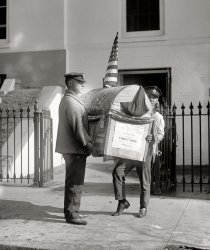
- Newark Newsies: 1909
- ... besides having the comics I loved. I remember a daily feature on the front page --"The Toll"--showing the number of Americans ... Posted by Dave - 03/27/2015 - 8:16pm -
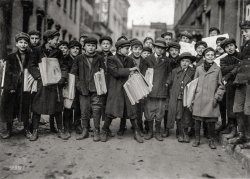
- Semaphore: 1920
- ... full size.
Riding on the Metro I ride by here daily on the Metro. I believe this is facing west [it's north-northeast - ... Posted by Dave - 09/11/2011 - 1:10pm -
![Semaphore: 1920 Washington, D.C., circa 1920s. "Union Station signals and tracks." National Photo Company Collection glass negative, Library of Congress. View full size.
Riding on the MetroI ride by here daily on the Metro. I believe this is facing west [it's north-northeast - Dave]. The landmark that stands out is the switching house, which is still there, and in the photo is at the lower middle slightly to the left. If I have my orientation, right, the Metro Red Line goes by on the left, where you can kind of see a train in the photo. This would be facing with your back to Union Station.
When I see the switching house, it looks like it's 100 years old. It's green-copper stained with some gray. Most of those tracks are still there, and there's now also some old electric train wires hanging overhead which may date back to the 50s (I am not sure).
Some things never change.I work for the Long Island RR, and it seems that very little changes in train yards. The equiptment changes with the times but not much else. It's definitely a bit of a throwback occupation.
K TowerThis is a fantastic photo of the place I have worked since 1990 - K Tower, Washington Terminal. It controls all of the former Washington Terminal signaled trackage. Semaphore signals were replaced in the 1950's with color position signals.
Richard Hafer
K Tower Train Director
(The Gallery, D.C., Natl Photo, Railroads)](https://www.shorpy.com/files/images/31702u_0.thumbnail.jpg)























